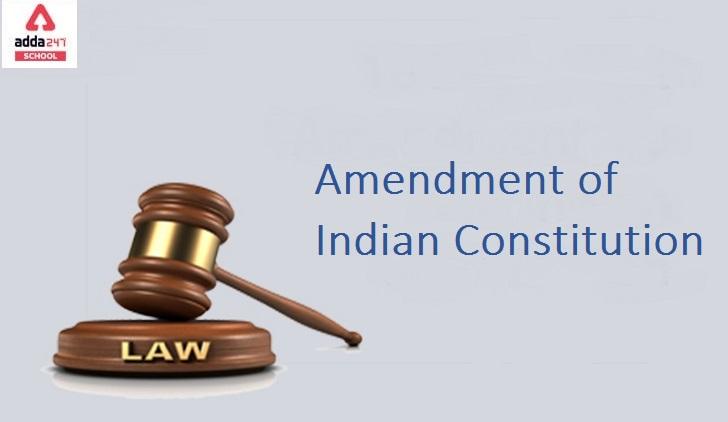How many amendments are there in Indian constitution?
List of Amendments of the Indian Constitution: The process of amending India’s Constitution entails making changes to the country’s fundamental law or supreme law. Part XX (Article 368) of the Indian Constitution lays forth the method for amending the constitution. This mechanism ensures the Constitution of India’s sanctity and limits the Parliament of India’s arbitrary power.
How many amendments in Indian constitution?
Nevertheless, there is another restriction on the amending power of the Indian constitution, which arose from disagreements between the Supreme Court and Parliament, in which Parliament wanted to exercise discretionary use of the right to alter the constitution while the Supreme Court wanted to limit it.
42nd amendment of the Indian constitution
The 42nd Amendment amended India’s designation from “sovereign democratic republic” to “sovereign, socialist secular democratic republic,” as well as the terms “national unity” to “national unity and integrity.” It aimed to limit the Supreme Court’s and High Courts’ ability to rule on the constitutionality of laws. It spelt out Indian citizens’ fundamental responsibilities to the country. The 42nd Amendment is often recognised as the most contentious amendment in American history.
The majority of the amendment’s provisions went into effect on January 3, 1977; others went into effect on February 1, and Section 27 went into effect on April 1, 1977.
44th amendment of the Indian constitution
The 44th Amendment to the Indian Constitution was enacted in 1978 by the 45th Amendment Bill. The 42nd Amendment Act was enacted in 1976, and numerous clauses were altered against the desire of the population; as a result, the 44th Amendment Act was enacted to reverse those modifications and protect the nation’s interests.
73th amendment of the Indian constitution
The 73rd Amendment establishes a three-tier Panchayat system that would be established at the village, intermediate, and district levels in each state. The Panchayati Raj structure in India became more uniform as a result of this provision.
At every level of the Panchayat, there is a provision for reserving seats for SCs and STs. At each level, seats will be reserved for SCs and STs in proportion to their population.
The State Election Commission would be in charge of overseeing, directing, and controlling Panchayat elections, as well as preparing electoral rolls.
It added Schedule 11 to the Indian Constitution, which contains a list of issues that fall under the jurisdiction of the Panchayat Raj institutions.
91st amendment of the Indian constitution
The 91st Amendment to the Constitution proposes to cancel the rearrangement of parliamentary constituencies scheduled for the censuses of 2001, 2011 and 2021. As a result, it undercuts what should be a defining feature of the Lok Sabha: that each voter has an equal voice in the national legislature. When debating the bill, parliament should assess whether a short-term fix to avoid delimitation should be allowed to damage the Constitution’s democratic foundation.
24th amendment of the Indian constitution
The Constitution of India’s Twenty-fourth Amendment allows Parliament to weaken Fundamental Rights by amending the Constitution. It also changed article 368 to make it clear that Parliament has the authority to amend any section of the Constitution.
Read About: Mahatma Gandhi
104th amendment of the Indian constitution
The 104th Constitutional amendment extends by ten years the deadline for the abolition of reserving of seats in the Lok Sabha and State Legislative Assemblies for members of Scheduled Castes and Scheduled Tribes.
FAQs on list of amendments of the constitution of india
In the Indian Constitution, how many amendments have been made so far?
Since 1950, when the Constitution of India was first enacted, it has been amended 105 times, as of August 2021.
What is India’s Constitution’s 72nd Amendment?
To provide a temporary provision for determining the number of seats designated for Scheduled Tribes in the Tripura State Assembly until the seats are re-adjusted based on the first census after the year 2000, as required by Article 170 of the Constitution.
What are the procedures for amending India’s Constitution?
Only via the introduction of a Bill in either House of Parliament can the Constitution be amended. The Bill must next be approved by a majority of the entire membership of each House, as well as a majority of not less than two-thirds of the members present and voting in each House.
What does the 52nd Amendment entail?
To accomplish this, the Indian Parliament passed the Tenth Schedule of the 52nd Amendment to the Constitution of India in 1985.
What are the three different types of amendments?
The Bill of Rights, Civil War amendments, and twentieth-century amendments are the three types of constitutional amendments.









 HPBOSE Compartment Date Sheet 2025 Out, ...
HPBOSE Compartment Date Sheet 2025 Out, ...
 RUHS Counselling 2025 Round 1 Seat Allot...
RUHS Counselling 2025 Round 1 Seat Allot...
 Bihar Board Dummy Registration Card 2026...
Bihar Board Dummy Registration Card 2026...










